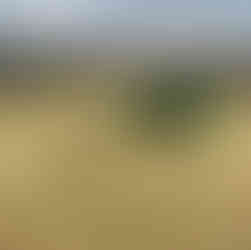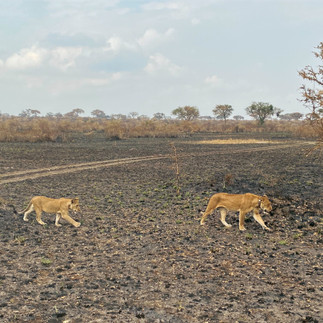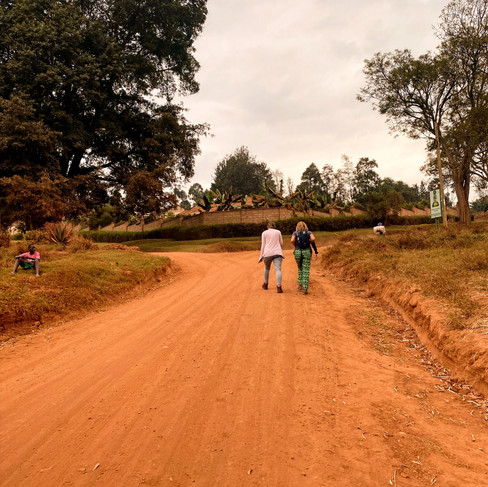Volunteering with Mission Rabies in Uganda
- Fanny

- Aug 6, 2022
- 12 min read
Updated: Jun 11, 2023
I can’t believe my two weeks in Uganda are already over! I’ve been blessed to discover this beautiful country through a different lens thanks to my volunteering with Mission Rabies. This took us to some remote locations and unimaginable areas where I guess the common tourists would not have ventured probably. Let me take you through this 10-day unforgettable journey followed by a 3-day safari at the end.
Volunteering with Mission Rabies
As shared in my last post where I recounted my first impressions about Uganda, our trip took us across the country from Entebbe to Kabale where we set our initial temporary HQ for 6 days, at the White Horse Inn. The place is lovely set at 2’000m high, amidst tea plantations and has a large garden, where we would sit after each field day, sharing our stories with each other while cheering on a glass of wine or a beer before dinner.

During our briefing on day 1, we learned how the vaccination campaign will run and also got to know our team mates. Being a total of 18 volunteers, we formed 6 teams of three persons (e.g. triads): each composed of 2 international volunteers (in the sense that none of us could speak the local language) and 1 local volunteer who would speak Ugandan and other dialects, such as a Rukiga, the dialect of the Southwest. Each triad included at least a vet or vet nurse, as the vaccine is not allowed to be administered by someone who isn’t trained on handling a syringe in an animal (aka someone like me). Each team also got a triad nickname and that’s how the Gorillas, Chimps, Kobs, Turacos, Cranes and Pythons came together on their mission to vaccinate as many dogs as possible against rabies during the next 9 days.

Each team had his own supplies to manage for the week: dog rabies vaccine vials in a cooler box, needles, syringes, disinfection liquid, gloves, a phone with the tracking app, vaccination cards, pens and markers, educational flyers in local languages, a banner and not to forget a loudspeaker for announcing our venue in each village. These items were essential to a successful day in the field.
Our days were packed with action and started at 6.30am each morning, when breakfast was served while the sun was rising and the morning fog still dissipating. By 7.15am we would be ready on the carpark, waiting for the daily short briefing by Jo (one of the two Mission Rabies team leads) that started with our team chorus of “Good morning Jo!”. Each team was assigned to a specific location indicated on the team phone that would change every day (we also had sometimes two locations to cover in a day) and a jeep with a driver was designated for each team.
Our “Chimps” triad - composed of Nick (a retired vet from the UK), Brian (a nurse from Kanungu district CT, Butogota town council area) and me – was super motivated and eager to get going. See our big smiles on this photo taken on Day 1:

For our first day of vaccination, we were stationed at Kabale stadium, in the heart of town where we arrived shortly before 8am. It was a slow start as no one came with a dog until 10am and we were getting anxious! Nick had the syringes ready and waiting patiently. In the meantime, Brian, Priscila (a vet from the Ministry of Agriculture observing the overall mission) and myself went for a walk in the surrounding streets with the loudspeaker to inform locals of the opportunity that laid ahead of them for today: get their dog(s) vaccinated against rabies for free. To my relief, several locals spoke English and I was happily chit-chatting with them, enquiring if they had a dog at home and if they knew about rabies disease and its fatal outcome if a person was bitten by a rabid dog.
An important fact about dogs in Uganda: most of them are owned and are not strays, instead of how I imagined (unlike India, Sri Lanka and other parts of South East Asia where many dogs are wandering freely around the streets). This point is actually essential as it determines the strategy to be employed for the vaccination campaigns. In our case, the campaign was run as “Static Vaccination Point” which means it is expected the owners would bring their dog(s) to the location where we would administer the vaccine, rather than us going door-to-door to vaccinate the dog in their home environment. This strategy brings the advantage that it maximize our time and efficiency by enabling to vaccinate many dogs in a single area within a limited amount of time.
One difficulty is that many dogs are not used to walk on the leash, as they are often used as “guard dogs” at home and tied to a chain most of the time. So we saw many dogs arriving to us in a stressed or fearful state, sometimes by force, which we had to manage to the best of our ability to avoid any potential bite (as an anxious dog may resort to biting). It was an important learning for us, and we paid close attention to this as the days passed to avoid poor welfare and ensure appropriate handling of each dog as much as possible.
The vaccination process ran as follow:
Brian or me (depending if the dog’s owner understood English) would explain how to restrain the dog in a safe and non-abusive manner. See picture below:

Once the dog and his owner were in position, Nick would approach from behind and inject the vaccine subcutaneously in the back’s skin of the dog, or sometimes intramuscular in the dog’s thigh, depending if the dog was moving.
Brian or myself would apply a red paint with an animal’s marker on the dog’s head, to show that animal is indeed vaccinated.
Meanwhile Brian or myself would complete the vaccination card, that indicates the dog’s name, color, sex, owner’s name and address, as well as display the vaccine sticker and date of vaccination. This card is given to the owner and is essential for 2 reasons: first, it shows the dog is “safe” and protected against rabies for 1 year; the owner will have to bring the card next year at the next vaccination campaign. Secondly, in case the dog bites someone, the card can be shown to the medical staff/vet authorities so that the bitten person doesn’t have to receive rabies post-exposure prophylaxis if not necessary and also avoid putting the dog to sleep/monitoring it as it could not be rabid if properly vaccinated. The post-exposure prophylaxis human vaccine or immunoglobulins are both costly and in short supplies within Uganda (as many Low Income Countries), hence it is paramount that is used sparingly and with caution.
Lastly, Brian or myself would complete a form within the tracking app in the phone, as it is important to record how many dogs received the vaccine, understand the percentage of male/female, their sterilization status, if puppy or adult, as well as how the owner heard about the vaccination campaign. This helps plan future campaign logistics and provide metrics that can be shared with the government too.
In order to be successful, a vaccination campaign usually requires to reach a 70% vaccination rate of the dog community to achieve herd’s immunity. This goal is an ambitious one, and a lot of preparation has been carried out ahead of our campaign field dates, by the Mission Rabies team and local partners on the ground to ensure announcements were made on the radio, shared with the district veterinary officers and that local chairpersons and/or church leaders were on-board with the campaign and supportive of it, so the communities could be well informed and not miss the opportunity to get their dog vaccinated for free. It’s worth keeping in mind that the average Ugandan lives with 670 USD per month (lowest 170 USD monthly [1]) and that >80% of the population lives in rural areas [2], from agricultural livelihood and have little access to both healthcare and veterinary care. Spending money on vaccinating a dog (not to mention the logistical complexity to bring the dog to a vet when you don’t have a mean of transportation) is therefore not necessarily a priority, albeit this could save a child’s life.
In spite of our starting day as Chimps team not being as successful as we had hoped for in terms of numbers, we were energized and met many happy dog owners who were grateful for the opportunity to protect their dog(s), famil and surrounding community from the deadly rabies disease. Some teams did vaccinate over 110 dogs during the 8 hours of their day: that’s basically 1 dog every 4-5 minutes, quite an efficient throughput!
The next 5 days unfolded in a similar manner and we covered many areas around Kabale, some remote and hard to reach (I had my own share of fear with the jeep going up dirt tracks…). We were often stationed next to a marketplace or next to the village church – most of them named Church of Uganda or Church of England – which are usually next to the village school. That brought unforgettable moments when dozen (if not hundred) of kids would stop and watch us, smile and say hello or laugh out when they heard the few words of Rukiga that I managed to pronounce: “Agandi?” which means “How are you?” or “Kari kari” to say goodbye.
Most day-to-day life in Uganda is centred around agriculture, producing food and herding animals (primarily goats and sheep, but we also saw a fair share of cows) in the beautiful pasture and fields that the country offers. The typical household does have partial access to electricity however no running water and no stove. Hence a daily task is fetching water and wood to be able to cook (most cooking is done outdoor with firewood). An Ugandan woman spends an average of 9-12 hours on daily chores to run the household. Observing the local routine has been eye opening in many ways, and humbling too. Simplicity, curiosity and kindness with a genuine smile is what I will remember from my interactions with the communities during this trip.
After 5 days in Kabale, we moved our temporary HQ to another city further South and right next to the border with Rwanda: Kisoro. The road to Kisoro is quite scenic and made us go through a pass and brought us closer to the mountains, where the infamous Bwindi Impenetrable National Park lays – home to the mountain gorillas (more on this later).
Kisoro is also close to the Democratic Republic of Congo, where there is an ongoing military conflict in the Eastern region. We saw UNHCR camps set along the main road where Congolese refugees have been living for the past few months. One day, a man came to our vaccination point speaking in French and was sharing his story with me. He was a teacher but had to flee DRC; now that he’s in Uganda he was looking for food to give to his goat as he was trying to make a living and get back on his feet.
After 3 days in Kisoro, we moved to our final location: Buhoma. This village is more developed than most because the headquarters of the National Park are located here and many tourists stay overnight here before trekking through the park. The importance of vaccinating dogs in this area is quite strategic for the government, as rabies is transmissible to gorillas and other mammal wildlife. Although the risk of a dog/gorilla confrontation is low, this is not a risk anyone would take as gorillas are an endangered species and the revenues generated from tourism are not negligible here.

Eventually after 10 days of being together, the campaign was over and it was time to bid farewell. The last evening was full of celebration and laughter as each of us received his/her certificate and thank you cards from the Mission Rabies team. Collectively, we vaccinated around 2’700 dogs in the span of 9 days across >60 villages and communities in the Southwest province of Uganda – something to be proud of!
If you want to learn more about the great work Mission Rabies is carrying across several African countries and in South East Asia, you can check their website or follow them on Instagram @MissionRabies or on Facebook.
Discovering the wildlife of Uganda
Being already 10 days in the “Pearl of Africa”, I had ample opportunities to observe the local life and admire the beautiful landscapes and hills across the country. However my trip would not have been complete without a chance to witness the unique wildlife, and you know how fond I am of animals by now 😉 a few of us had pre-arranged a safari with AJ tours – which I highly recommend for any tour in Uganda and East Africa.
We drove out of the mountains and went to the plains bordering DRC. What a change of scenery: from lush green and misty mornings to yellow savannah and dry & warm evenings, I almost forgot I could sweat! The Queen Elizabeth National Park is a game reserve of 1,978 square kilometers and include part of the Lake Edward & Lake George, connected by the Kazinga channel. We got extremely lucky, as we saw lions, kobs, buffalos, elephants, warthogs, but also countless birds, a few crocodiles, and even spotted the head of a leopard coming out of the high grass. We also went on a small boat tour on the channel and could admire several of those closer, including many hippos, as these were drinking or resting in the water. Nature won’t ever cease to amaze me!
On our way back from Queen Elizabeth NP, we also met with numerous baboons, who for some reason where looking for food or hanging out next to the main dirt road. We were heading back for Bwindi Impenetrable NP for the last day of our safari and our excitement kept growing despite the long drive of 9 hours. Our permits to enter the NP and do the trek were booked several months ago, as there are only 32-40 permits per day per area to enable sustainable tourism and ensure the gorillas are not overexposed to humans. The next morning, we woke up at 6am full of energy and ready for the trek of our lifetime.
After passing by the NP office where we received our briefing and were greeted by the rangers, our group of 7 hikers (+ 1 ranger, 1 police officer, 1 security guard and some porters for those who wished one) started the hike around 8.30am. The mountain jungle was a deep green and thick. The hike can last between 3 and 6 hours, depending how far the gorillas are and how accessible the path to get there is. After 1,5 hours including the last 30 minutes that felt like climbing vertical stairs in soil & jungle roots (grateful for the walking stick) our ranger announced we were near the gorilla group. We had to put on our face masks (note: gorillas, like many other animals, can catch COVID-19 too) and had to take our last sip of water for the next hour. We were reminded about the safety rules which included speaking at low voice, no flash photography, and in case of danger: do not run!!
We ventured for another 20 meters through thick bushes cut by the machetes of the rangers and finally, my heart start pounding, right in front of us, a mere 6 meters away, was laying a silverback male gorilla on the floor. I had to admit, I got shit-scared the first 10 minutes and was wondering if coming here was such a good idea after all. What if he got angry and decided he didn’t want any visitor today?! It took a bit of time to get accustomed to him (and I guess similarly for him) as he made those grunting noises, which I interpreted at first as anger/annoyance, but the ranger later explained these noises are part of their communication vocabulary. The ranger himself was making identical noises, as this is a way for the silverback to recognize him (note: each ranger is assigned to a specific group of gorillas, so they always go to the same group and the silverback gets accustomed to one specific ranger only).
Together with the silverback was a 1 year-old baby and a female nearby. We learned this silverback male is around 28 years old; mountain gorillas can live up to 60 years in the wild. We were told it is rare they can be bred in captivity (unlike lowland gorillas) because of unsuitable habitat and conditions. We got one hour to observe them and take pictures/videos before we had to leave. These rules are strictly enforced, again to limit exposure to humans and avoid unnecessary stress to them. The time passed like in a flick moment; it was magical, I was in awe and deeply appreciative for this chance to observe mountain gorillas in their natural habitat.
My experience of Uganda, as often when I discover a country for the first time, was nothing short of mesmerizing and eye opening in many senses, miles away from my routine in Singapore or previously in Switzerland. If I had to summarize Uganda in 4 words, these would be the following ones:
Red dust (or mud if rainy): the soil color is striking on pictures and contrast with the omnipresent green background. Hard not to notice as most roads are not paved and dirt tracks, that generate lots of dust when driven on. My nose will certainly remember.
Bananas, of which many varieties exist: Makooke being a staple of Ugandan food (it looks like mashed potatoes)
Football, which is omnipresent as each village has cages next to the school where kids run to play during recess
Goats, as these are ubiquitous across the country. I stopped counting how many times I mistakenly thought there was a dog by the road when in fact it was a goat. This brough me to declare “Goats are the new dogs”. They are source of livelihood for many Ugandans, providing food for self or money when sold.
I am grateful for this opportunity to contribute, together with other volunteers, to one of Mission Rabies vaccination campaigns in dogs, while discovering a country of which I will keep a fond memory in my heart. I hope this may have given you the curiosity to discover it too!
Thanks for reading and til the next adventure…














































































































Great work Fanny... thanks for sharing your experience while volunteering in Uganda. We hope to see once again in Uganda. A.J tours🤣
Wow! Such a great read. I have to admit that seeing those gorillas brought a tear to my eye. How amazing to be that close to these incredible creatures. Thank you for sharing and great work with volunteering in the rabies vaccinations program. Incredible!
Captivant